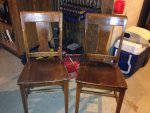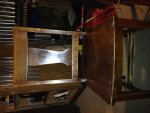- Messages
- 6,033
- Location
- Plainwell, Michigan
I have picked up 6 old (1920ish?) chairs for our dining room and are in need of refinishing. Now I have never stripped anything and sure could use some guidance on what to use to strip them. This will be a winter project done in my basement shop if that means anything as to what kind of stripper to use. Thank you in advance and will post as I proceed. Here is an as is





 Can't hurt and no nasty chemicals
Can't hurt and no nasty chemicals


